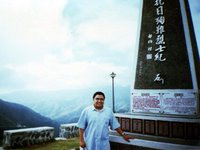
Today, the delegates of the ICOMOS-CIAV Scientific Conference 2007 proceeded to Banaue where we will be staying for the next few days. The scientific conference is an annual meeting of vernacular heritage experts from around the globe. I was asleep for most of the trip since I did not get enough sleep the previous nights. We stopped by Balete Pass along the way. More popularly known as Dalton Pass, this marks the boundary between Nueva Ecija and Nueva Vizcaya, and therefore Central Luzon and Cagayan Valley as well.

We had a sumptuous lunch at the Governor's Hotel in Solano town. As we arrived, we were welcomed by a marching band from the local elementary school. After lunch, we were off to Banaue. Again, I was fast asleep so there's nothing much I could say. And the next thing I knew, we had arrived.

The view from my room in the Banaue Hotel was great. Imagine waking up in the morning and the first thing you'll see are rice terraces and tree-covered mountains. Dinner was superb too! It looks like I'll be gaining more pounds if they keep dishing up this great selection of dishes.
How to get to Banaue, IfugaoFlorida Bus has a regular trip from Manila direct to Banaue. It leaves Sampaloc, Manila (Lacson St. cor. S. H. Loyola St.) at 10:45 p.m. Or you can take any bus that goes to Cagayan Valley and get off at Solano, Nueva Vizcaya where you can catch regular trips to Banaue and other towns in Ifugao. From Baguio, KMS Bus Lines and Ohayami Trans leave for Banaue at least twice daily.


















